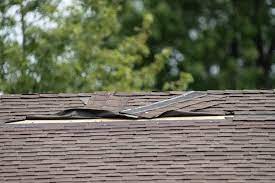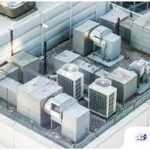The roof of your residence serves as its primary barrier against environmental elements, making it especially susceptible to wind-induced damage. Significant damage to your roof is possible in the event of a powerful storm, hurricane, or even sustained high winds over an extended period. Such damage necessitates urgent attention. This blog will examine the ramifications of wind damage on roofs, the procedures involved in assessing the damage, and the restoration methodology that guarantees the revitalization of your roof.
Comprehending the Consequences of Wind Damage
Wind damage can manifest in a multitude of ways and affect distinct sections of an edifice. Among the frequent consequences of wind damage are:
- Shingle Destroy: Violent winds have the potential to lift, curl, or rip shingles from a roof. This not only undermines the structural integrity of the roof but also renders the underlying framework susceptible to moisture and additional harm.
- Lifting and Separation: Wind-generated upward pressure on the roof can induce lifting and separation of shingles from the roof deck. This may eventually result in leaks and additional damage.
- Blow-Offs: Severe wind conditions can result in the removal of entire sections of shingles from a roof, exposing the roof deck.
- Fractures and Cracks: As a result of the stress that high winds can place on roofing materials, shingles, tiles, and other roofing components may develop cracks or fractures.
- Damage to Flashing: Wind-induced damage or displacement of flashing surrounding chimneys, vents, and skylights may result in water infiltration through the roof.
- Debris Impact: Strong-wind-carried flying debris is capable of causing punctures, dents, and other types of damage to the roof.
Evaluation of Wind Damage
As soon as possible after suspecting wind damage to a roof, it is critical to conduct an assessment of the damage’s extent. The necessary steps are as follows:
- Safety First: Ensuring safety should be your primary concern. It is advisable to refrain from ascending onto the roof oneself, particularly in situations where further wind damage or structural instability may ensue. Instead, inspect the roof from the ground using binoculars or by hiring a professional roofing contractor.
- Exterior Inspection: From a secure vantage point, perform an exterior inspection of your roof. Inspect for damage, missing, or lifted shingles, in addition to any overt indications of structural deterioration.
- Interior Inspection: Reconnaiss any indications of water infiltration, discoloration, or daylight ingress in the attic or upper levels of your residence. The aforementioned are signs of roof damage that demand urgent attention.
- Check Flashing and Vents: Conduct an inspection of the flashing surrounding chimneys, vents, and other apertures in the roof to identify any signs of damage or displacement. Ensure that they are fastened in place securely.
- Document the Damage: Photograph or record videos of the damage for the purpose of documentation. When discussing repairs with contractors or filing insurance claims, this will prove to be beneficial.
The Restoration Methodology
There are multiple stages involved in restoring a wind-damaged roof, beginning with an initial assessment and concluding with the final repair. The following is a synopsis of the restoration procedure:
- Inspection by a Professional:
- Obtain the services of a reputable roofing contractor who specializes in wind damage repair. A thorough examination will be undertaken in order to evaluate the complete magnitude of the damage.
- Urgent Maintenance:
- Critical wind damage that exposes a residence to the elements may necessitate immediate repairs. Possible solutions include employing temporary patching or tarping techniques to impede additional water infiltration.
- Insurance Demands:
- When your roof is damaged and covered by insurance, promptly file a claim. Please furnish your insurance company with all pertinent documentation and evidence regarding the observed damage. Be ready to collaborate with their adjuster in order to determine coverage and assess the damage.
- Damage Evaluation:
- Your roofing contractor will collaborate with the insurance adjuster to assess the damage and agree on a scope of work for replacement or repairs once the insurance claim has been filed.
- Selection of Material:
- The extent of the damage will dictate whether the damaged areas are to be repaired or whether a complete roof replacement is necessary. The contractor will furnish recommendations in accordance with their evaluation.
- Elimination of Destroyed Materials:
- The damaged roofing materials, such as tiles and shingles, will be removed to expose the roof deck in the event that a roof replacement is required.
- Repaired Structural Elements:
- During this phase, any underlying structural damage will be remedied. This may require reinforcing or repairing decking, rafters, or trusses.
- Implementation of Novel Roofing Components:
- After restoring the roof deck to a satisfactory state, replacement roofing materials will be affixed. Underlayment, flashing, and shingles or tiles are included. Materials of superior quality are required to withstand future wind events.
- Quality Assessment:
- A comprehensive examination will be carried out to verify the proper installation of the roofing materials, the presence of flashing and ventilation, and the adherence of the roof to industry standards.
- Disposal of Debris and Cleanup:
- The contractor will undertake the task of debris removal and work area cleanup upon the conclusion of the restoration process at your property.
- Concluding Evaluation:
- Frequently, both the roofing contractor and the insurance adjuster will conduct a final inspection to confirm that the replacement or repairs adhere to the agreed-upon scope of work.
- Documentation
- Maintain a comprehensive record of all documentation pertaining to the restoration procedure, encompassing inspection reports, invoices, and warranty particulars.
To reclaim your roof with wind damage repair, follow these essential steps to ensure a thorough and effective restoration process.
Preventing Wind Damage in the Future
Although complete prevention of wind damage is unattainable, there are measures that can be implemented to mitigate the potential harm and safeguard the roof:
- Regular Maintenance: It is advisable to establish a routine for roof inspections and maintenance in order to proactively identify and resolve potential issues.
- Secure Loose Items: Secure any loose items in your yard that could become projectiles in high winds prior to a windstorm.
- Trim Trees: Maintain tree trimming in the vicinity of your residence to avert the risk of branches landing on the roof in the event of storms.
- Choose Quality Materials: Invest in premium roofing materials that are specifically engineered to endure adverse weather conditions, including wind.
- Professional Installation: Ensure that the installation of your roofing materials is carried out by seasoned professionals who adhere to the most effective methods in the industry.
To Conclude,
Roof damage caused by wind is an urgent matter that demands immediate attention in order to safeguard the residence and avert additional harm. You can restore your home’s roofing system and guarantee its safety, integrity, and longevity by diligently adhering to the restoration process, promptly assessing the damage, and collaborating with professionals. It is imperative to bear in mind that prudent investment in high-quality materials and expert installation is fundamental in order to mitigate the potential for subsequent wind damage and optimize the longevity of your roof. For more information on wind damage repair, view the Pinnacle Exteriors’ website.



